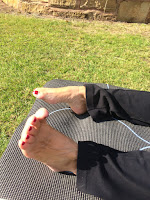Pawanmuktasana 1. Anti-Rheumatic Group. Part 1 (Toes and Ankles)
Sometimes if you miss a yoga class, you feel like you
could really do with a gentle yet efficient workout at home. Or after a day in
the office, working sat at the desk most of the time, you feel like you need to
relax the stiffness and muscular tension.
For this purpose I would like to share a really wonderful
series of asanas called “The Pawanmuktasana Series”. In Sanskrit “Pawan” means “wind”
or “prana”; “mukta” means “release” and “asana” means “pose”. Therefore, Pawanmuktasana is a group of asanas that is aimed at removing any blockages preventing
the free flow of energy in the body and mind. It is one of the special
contributions of the teachings of Swami Satyananda Saraswati. You can find them in full in the book Asana
Pranayama Mudra Bandha.
These series can be performed by a beginner or advanced,
young and elderly. They should not be
ignored just because the practices are simple, gentle and comfortable.
In this and the next couple of publications we will consider
the first part of the exercises, which is called “Anti-Rheumatic Group”.
It is aimed at:
-
releasing tensions from the joints of the body
-
promoting health overall
-
improving coordination, self-awareness and
self-confidence.
It is excellent for
those with:
-
rheumatism
-
arthritis
-
high blood pressure
-
heart problems
-
or other ailments where vigorous physical
exercise is not advised.
Awareness:
The practices can be
performed in 3 ways:
1.
With
awareness of the actual physical movement, the interaction between the
various components of the body (bones, joints, ligaments, muscles etc), with
mental counting of each round and with awareness of thoughts arising in the
mind. This method induces peace and balance bringing harmony in the physical
body.
2.
With awareness
and integrated breathing. The movements become slower, which in turn slows
the brain waves, further enhancing relaxation. This has a greater effect on harmonising
physical body and breath.
3.
With awareness
of the movement of prana. Prana may be experienced as a tingling sensation
in the body to which one becomes sensitized with practice.
Right-handed people will find that it is easier to perform the activities on the right side. They should also be performed on the left side, to counterbalance the effects of habitual behaviour patterns.
If tiredness is experienced at any point of this asana
program, rest in savasana.
For maximum benefits eyes can remain closed. Do not practise
mechanically, be aware through the practice.
All the practices of pawanmuktasana part 1 are performed
while sitting on the floor in the base position. The body should be relaxed , and
only the muscles associated with the asana being executed should be used.
There are 17 practices in this group, and today we will consider first 4 of these practices, working with toes and ankles.
Prarambhik Sthiti (Base Position).
Sit with legs stretched, feet close together but not
touching. Prarambhik Sthiti (Base Position).
Place the palms of the hands on the floor to the sides, just
behind the buttocks.
The back, neck and head straight. Straighten the elbows.
Lean back slightly, taking the support of the arms. Close the eyes and relax.
1) Padanguli naman (toe bending)
Hold each position for a few seconds. Repeat 10 times.
Breathing: Inhale as the toes move backward. Exhale as the
toes move forward
Awareness: on the stretching produced by the movement and the
breath.
2) Goolf naman (ankle bending)
Breathing: Inhale as the feet move backward. Exhale as the
feet move forward.
Awareness: on the stretch in the foot, ankle, calf and leg,
and the breath.
3) Goolf Chakra (ankle rotation)
a)
Slowly rotate the right foot clockwise from the
ankle 10 times and then repeat 10 times anti-clockwise. Repeat the same on the
left foot.
b)
Slowly rotate both feet together in the same
direction. Focus on rotating the feet and not the knees. 10 times clockwise and
10 times anti-clockwise.
c)
Keep feet separated. Slowly rotate both feet
from the ankles together, but in opposite direction. 10 times in one direction
and 10 rotations in the opposite direction.

Breathing: Inhale on the upward
movement and Exhale on the downward movement.
Awareness: on the rotation of the
ankle and the breath.
4) Goolf Ghoornan (ankle crank)
Bend the right knee and bring the foot towards the groin.
Turn the knee out to the side and if there is no strain, gently place the foot
on the left thigh.
Make sure the ankle is far enough over the thigh to be free
for rotation.
Hold the right ankle with the right hand. Hold the toes of
the right foot with the left hand.
With the aid of the left hand, slowly rotate the right foot
10 times clockwise and 10 times anti-clockwise.
Change leg and repeat on the other side.
Breathing: Inhale on the upward movement. Exhale on the
downward movement.
Awareness: On the breath, mental counting and rotation,
Benefits: All the foot and calf asanas help in returning the
stagnant lymph and venous blood. They thus relieve tiredness and cramp, and
prevent venous thrombosis.
In the next publication we will consider the next 5 asanas,
which will involve working with the knee muscles.
Happy practicing!
P.S. Special thanks to Carol, who has kindly agreed to demonstrate the asanas.
P.S. Special thanks to Carol, who has kindly agreed to demonstrate the asanas.














Comments
Post a Comment